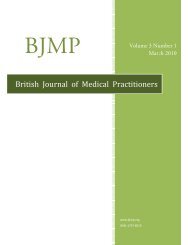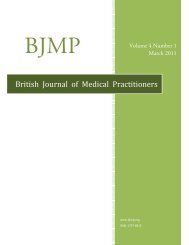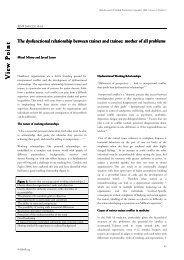R esearch A rticle - British Journal of Medical Practitioners
R esearch A rticle - British Journal of Medical Practitioners
R esearch A rticle - British Journal of Medical Practitioners
You also want an ePaper? Increase the reach of your titles
YUMPU automatically turns print PDFs into web optimized ePapers that Google loves.
<strong>British</strong> <strong>Journal</strong> <strong>of</strong> <strong>Medical</strong> <strong>Practitioners</strong>, March 2013, Volume 6, Number 1<br />
proportion may be higher than the 17% identified by key<br />
workers. Documentation <strong>of</strong> treatment outcomes, using TOP<br />
reports and UDS results, was unsystematic, limiting the number<br />
<strong>of</strong> patients in whom complete data was available. “Nonresponders”<br />
self-reported heroin use to keyworkers, who<br />
administered the TOP questionnaire, and there may have been<br />
under-reporting. However, while this study may not have<br />
identified all non-responding patients, this does not invalidate<br />
the observation that attempting to implement guidelines was<br />
not successful.<br />
Most importantly, the observations from these clinics may not<br />
be generalisable to other treatment settings. However, certain<br />
key data are available suggesting the treatment and outcomes<br />
observed in this study were not atypical. A report on national<br />
TOP monitoring noted patchy availability <strong>of</strong> follow-up data,<br />
and confirmed a high rate <strong>of</strong> persisting heroin use in treatment,<br />
with 38% <strong>of</strong> participants reporting abstinence from heroin 18 .<br />
Despite this high rate <strong>of</strong> heroin use, a recent survey reported a<br />
mean dose <strong>of</strong> 56mg <strong>of</strong> methadone in a national survey 19 . In this<br />
regard, the clinics in this report thus seem representative.<br />
<strong>Medical</strong> staff appeared to have a peripheral role in delivery <strong>of</strong><br />
OST in these clinics. Most non-responders did not have a<br />
medical review in 6 months – despite persisting heroin use, and<br />
self-reported depression. In the 1980s in the US, methadone<br />
treatment underwent a process labelled “demedicalisation”,<br />
marginalisation <strong>of</strong> the role <strong>of</strong> medical practitioners, and a loss <strong>of</strong><br />
the sense that methadone was a medical treatment with clearly<br />
defined objectives and guidelines 20 . This contributed to a<br />
situation in which much methadone treatment in the US was<br />
out <strong>of</strong> line with r<strong>esearch</strong> evidence 21 . The current audit suggests<br />
that a similar process <strong>of</strong> demedicalisation and deviation from<br />
evidence-based treatment has been occurring in some NHS<br />
services in the UK.<br />
If these observations are representative <strong>of</strong> at least some<br />
treatment culture in the UK, they lend support to the criticisms<br />
made <strong>of</strong> methadone treatment in the new UK drug strategy 1 .<br />
To the extent that the recovery agenda challenges clinic culture<br />
and shifts the focus <strong>of</strong> treatment onto outcomes, it is a positive<br />
development.<br />
However, many well-intentioned policies have unintended<br />
consequences, and there are well-based fears that the new policy<br />
promoting abstinence from OST as an objective <strong>of</strong> recovery will<br />
lead to an increase in overdose deaths 3 . This is specifically<br />
because <strong>of</strong> the risk <strong>of</strong> overdose deaths after leaving treatment.<br />
The reason for the increased risk <strong>of</strong> overdose after leaving<br />
treatment is that newly abstinent addicts who have reduced<br />
opioid tolerance, and a dose <strong>of</strong> heroin they previously used<br />
during periods <strong>of</strong> addiction becomes a potentially fatal dose<br />
once they are abstinent. This risk attaches to all forms <strong>of</strong> drug<br />
free treatment, as well as to patients who have left methadone.<br />
The critical issue is that lapses to heroin use, and relapses to<br />
dependent heroin use, are very common among newly-abstinent<br />
addicts. It is the high probability <strong>of</strong> relapse to heroin use which<br />
is the basis <strong>of</strong> long-term maintenance treatment – better to keep<br />
people safe and functioning normally, albeit while still taking a<br />
medication, than the risk <strong>of</strong> relapse and re-addiction, or relapse<br />
and fatal overdose. In the UK, implementation <strong>of</strong> the recovery<br />
agenda has included incentives to abstinence, and this is not<br />
consistent with evidence about the risk <strong>of</strong> relapse. If the<br />
recovery agenda can accommodate the evidence that indefinite<br />
maintenance as a valid option for many, perhaps most heroin<br />
users, then the evidence <strong>of</strong> this study is that far from being in<br />
contradiction, the recovery agenda may facilitate the<br />
implementation <strong>of</strong> evidence-based practice.<br />
Acknowledgements<br />
Dr Faizal, Ms Healey and Dr Bell devised the study and supervised conduct <strong>of</strong> it.<br />
Ms Kennedy undertook data collection and with Ms Healey, data analysis. Dr<br />
Shah and Dr Faizal delivered clinical care, and Dr Shah assisted in data collection.<br />
Dr Bell wrote the paper. All authors commented on and edited the manuscript,<br />
and approved the final draft. Dr Bell has received r<strong>esearch</strong> support and support to<br />
attend conferences from Reckittbenckiser PLC, and has received consultancy<br />
services for Reckittbenckiser. Dr Faizal has received support from Reckittbenckiser<br />
to attend a conference. Financial support for this project came from Merseycare<br />
NHS Trust. Apart from this, all authors have received no financial relationships<br />
with any organisations that might have an interest in the submitted work in the<br />
previous three years, no other relationships or activities that could appear to have<br />
influenced the submitted work.<br />
Competing Interests<br />
Funding for this project was provided by Mersey Care NHS Trust.<br />
Author Details<br />
JAMES BELL, BA(Hons), MD, FRACP, FAChAM, South London and<br />
Maudsley NHS Foundation Trust, UK. CHRISTINE HEALEY BA (Hons),<br />
DipSW, MSc, MPhil, University <strong>of</strong> Liverpool, UK. FIONA KENNEDY BA<br />
(Hons), University <strong>of</strong> Liverpool, UK. MOHAMMAD FAIZAL, MBBS,<br />
MRCPsych, MBA, Clinical Director, Addictions, MerseyCare NHS Trust, UK.<br />
AADIL JAN SHAH, MBBs, MSc, MRCPsych, Consultant Psychiatrist, Cheshire<br />
and Wirral Partnership NHS Foundation Trust, UK.<br />
CORRESSPONDENCE: DR JAMES BELL, 63-65 Denmark Hill, London SE5<br />
8RS, UK.<br />
Email: James.bell@kcl.ac.uk<br />
REFERENCES<br />
1. HM Government (2010) 'Drug Strategy 2010: Reducing demand,<br />
restricting supply, building recovery: supporting people to live a drug<br />
free life', in HM Government (ed.), (London).<br />
2. Department <strong>of</strong> Health (2007), 'Drug Misuse and Dependence: UK<br />
Guidelines on Clinical Management', in Department <strong>of</strong> Health (ed.),<br />
(London).<br />
3. Strang J, Hall W, Hickman M, et al (2010), 'Impact <strong>of</strong> supervision <strong>of</strong><br />
methadone consumption on deaths related to methadone overdose<br />
(1993-2008): analyses using OD4 index in England and Scotland',<br />
BMJ, 341.<br />
4. Clausen T, Anchersen K, and Waal H (2008), 'Mortality prior to,<br />
during and after opioid maintenance treatment (OMT): A national<br />
prospective cross-registry study', Drug and Alcohol Dependence, 94 (1–<br />
3), 151-57<br />
5. Jürgens R, Ball A, and Verster, A (2009), 'Interventions to reduce HIV<br />
transmission related to injecting drug use in prison', The Lancet<br />
Infectious Diseases, 9 (1), 57-66<br />
6. M<strong>of</strong>fatt, S., Weatherburn, D., Donnelly, N. (2005), 'What caused the<br />
recent drop in property crime' Crime and Justice Bulletin, 85.<br />
7. Duke, K (2006), 'Out <strong>of</strong> crime and into treatment The criminalization<br />
<strong>of</strong> contemporary drug policy since tackling drugs together', Drugs:<br />
Education, Prevention & Policy, 13 (5), 409-15.<br />
8. Marsden, J, et al. (2008), 'Development <strong>of</strong> the treatment outcomes<br />
pr<strong>of</strong>ile', Addiction, 103 (9), 1450-60<br />
BJMP.org<br />
10







